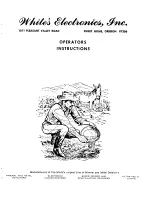
Searching.
When the detector gives a signal, move the search-head to the approximate
area where the signal was heard, hold the switch in pinpoint and move the
search-head carefully around. The strongest signal will occur directly below
the centre of the search-head. Dig a neat hole by cutting around the signal
position with a sharp edged trowel and remove a divot of earth which might
now contain the metal object. Run the detector over the area again in pinpoint
mode to see if the metal object is still in the hole or in the piece of earth which
you have just removed.
Dig some more and sift through the earth until you find what you are looking
for. Fill in the hole before moving on.
The use of headphones will increase battery life and make it easier to discern
faint signals.
Follow the ‘Countryside Code’. Do not trespass. Do not touch anything you
suspect might be live ammunition - inform the police.
Do not take your detector on any scheduled historic site. If you find
anything which looks like it could have historical significance, report it to
your local museum.
Acquaint yourself with any laws relating to the use of metal detectors
particularly if you want to go detecting in countries other than the UK.
9
Detecting with the CS6MX
CS
6MX






























